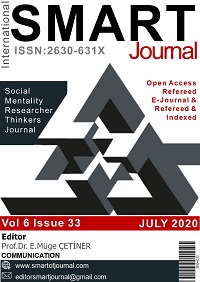Author :
Abstract
Bu araştırmanın amacı lise öğrencilerinin geometrik alışkanlıklarını origami kullanarak belirlemektir. Çalışmada origami ve cisim oluşturma etkinlikleri planlandı ve uygulandı. Çalışma gruplarına etkinlikler geometri ve matematik konularını içeren matematik dersinde gerçekleştirildi. Bu etkinlikler sırasında öğrencilerin geometrik alışkanlıklarını ortaya koyma yeterlilikleri belirlendi. Yetkinlikleri belirlemek için araştırmacı tarafından hazırlanan "geometrik zihin alışkanlıkları çalışma yaprakları" uygulanmıştır. Araştırmada öğrencilerin geometrik düşünme süreçleri dört bileşene göre incelenmiştir. Bu bileşenler, Driscol, DiMatteo, Nikula ve Egan (2007) tarafından “akıl yürütme ile ilişkilendirme, değişmezleri inceleme, geometrik fikirleri genelleme ve keşifleri yansımalarla dengeleme” olarak tanımlanmıştır. Araştırmanın çalışma grubunu Balıkesir merkezinde bulunan onuncu sınıfta (NS10 = 20) okuyan öğrenciler ve 11. sınıfta okuyan öğrenciler (NS11 = 20) oluşturmaktadır. Çalışmada öğrencilerin geometrik zihin alışkanlıklarının ortalamanın biraz üzerinde olduğu sonucuna varılmıştır. Ayrıca çalışmada, origami kullanarak geometride bir soruyu çözmek için iki ve daha fazla alışkanlığın kullanıldığı sonucuna varılmıştır. Araştırma, bilişsel ve duyuşsal boyutları içeren çalışmalar ile geliştirilebilir.
Keywords
Abstract
The aim of this research is to determine the geometric habits of high school students by using origami. During the study, formation of object and activities with origami were planned and implemented. The activities were held in the mathematics lesson related to geometry and mathematics working groups. The competencies of students to reveal their geometric habits were determined during these activities. "Geometric mind habits worksheets" prepared by the researcher were also applied to determine the competencies. In the study, students' geometric thinking processes were examined according to four components. These components have been identified by Driscol, DiMatteo, Nikula, and Egan (2007) as “associating by reasoning, examining invariants, generalizing geometric ideas and balancing discoveries with reflections”. The study group of the study consisted of the students studying in the tenth grade students (NS10 = 20) and 11th grade students (NS11 = 20) studying in the center of Balıkesir. It is concluded that the average of geometric mind habits is slightly above the average. Research can be developed through studies that include cognitive and affective dimensions.





